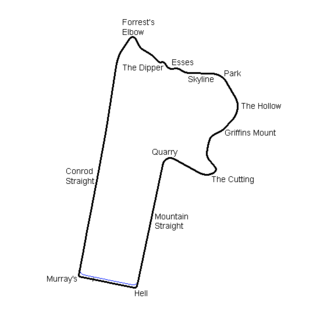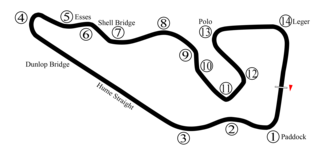
The 1964 Australian Formula 2 Championship was a CAMS sanctioned Australian motor racing title for racing cars complying with Australian Formula 2. The championship was contested over a single 30 lap, 90 mile race staged at the Lowood circuit in Queensland, Australia on 14 June 1964. It was the first Australian Formula 2 Championship.
The 1983 Australian GT Championship was a CAMS sanctioned Australian motor racing title for cars complying with Group D regulations for GT cars, with Group B Sports Sedans competing by invitation. It was the sixth Australian GT Championship. The championship was won by Rusty French, driving a Porsche 935.
The 1984 Australian GT Championship was an CAMS sanctioned Australian motor racing title and was the seventh Australian GT Championship to be awarded. It was a series open to grand tourer cars complying with CAMS Group D regulations with Group B Sports Sedans competing by invitation. The series was contested over six rounds from 15 April to 9 September 1984.
The 1963 Australian GT Championship was a CAMS sanctioned Australian motor racing title for GT cars complying with Appendix K regulations. The championship was contested over a single 10 lap race staged at the Calder Motor Raceway in Victoria, Australia on 8 December 1963. It was the fourth annual Australian GT Championship.

The Australian Tourist Trophy is a Confederation of Australian Motor Sport-sanctioned national motor racing title, contested between 1956 and 1979 by Sports Cars and, since 2007, by GT cars. The trophy is currently awarded to the outright winners of the Bathurst 12 Hour.

The 1966 Australian Grand Prix was a motor race staged on 20 February 1966 at the Lakeside Circuit in Queensland, Australia. The race, which had 15 starters, was open to Racing Cars complying with the Australian National Formula or the Australian 1½ Litre Formula. It was both the 31st Australian Grand Prix and race 6 of the 1966 Tasman Championship for Drivers.
The 1976 Australian Touring Car Championship was a CAMS sanctioned Australian motor racing title for Group C Touring Cars. It was the 17th running of the Australian Touring Car Championship. The championship began at Symmons Plains Raceway on 29 February and ended at the Phillip Island Grand Prix Circuit on 28 November in the longest season in the history of the series. 1976 saw a substantial change to the ATCC calendar which was expanded to eleven rounds, incorporating the end-of-season long distance Australian Championship of Makes races for the first time. These races included Sandown's Hang Ten 400 and the Phillip Island 500K, although notably not the Bathurst 1000.
John French is an Australian retired racing driver.

The 1970 Australian Formula 2 Championship was an Australian motor racing title for drivers of racing cars complying with Australian Formula 2 regulations. The title, which was recognised by the Confederation of Australian Motor Sport as the fourth Australian Formula 2 Championship, was decided over a single 40-lap, 60-mile (97 km) race, staged at the Lakeside circuit in Queensland, Australia on 27 September 1970. There were seven starters in the event.
Waggott Engineering was an Australian automotive engineering company which gained fame for the engines which it produced for motor sport applications from the 1950s through to the 1970s. The company had its origins in a machine shop opened in 1948 by Merv Waggott. Initially concentrating on commercial refrigerator repairs and general engineering it later diversified into the production of after-market parts for automotive and motor sport applications. This was followed in the mid-1950s by the development and production of the Waggott TC engine. Although based on the six-cylinder Holden “Grey” motor it was extensively modified with twin overhead camshafts, a special crankshaft and three twin choke Weber carburettors. As fitted to the Centaur Waggot in which John French won the 1962 Australian GT Championship, the engine was producing 202 bhp, over three times the 62 bhp output of the standard Holden unit.
The 1970 Australian Drivers' Championship was a CAMS sanctioned motor racing title for drivers of Australian Formula 1 and Australian Formula 2 racing cars. The winner of the title, which was the fourteenth Australian Drivers' Championship, was awarded the 1970 CAMS Gold Star.

The 1960 Australian GT Championship was a CAMS sanctioned Australian motor racing title for drivers of cars complying with Appendix K Gran Turismo regulations. The title, which was the inaugural Australian GT Championship, was contested over a single 50-mile race held at the Mount Panorama Circuit, Bathurst, New South Wales on 2 October 1960.

The 1961 Australian GT Championship was a CAMS sanctioned Australian motor racing title for Appendix K GT cars. The title, which was the second Australian GT Championship, was contested over a single 50 mile race held at the Warwick Farm circuit, in New South Wales, Australia on 30 July 1961. The race was conducted by the Australian Automobile Racing Co.

The 1965 Australian Formula 2 Championship was a CAMS sanctioned motor racing title open to Racing Cars complying with Australian Formula 2. The championship was contested over a single, 34 lap, 76.5 mile (123 km) race at the Warwick Farm circuit in New South Wales, Australia on 19 September 1965. It was the second Australian Formula 2 Championship to be awarded.
The 1987 Australian Sports Car Championship was a CAMS sanctioned Australian national motor racing title open to Group A Sports Cars, Group D GT cars, FISA Group C1 cars and FISA Group C2 cars.
The 1971 Rothmans 250 was motor race for Group E Series Production Touring Cars. It was staged on 7 November 1971 at the Surfers Paradise International Raceway in Queensland, Australia, over a 250-mile distance. The race, which was Heat 5 of the 1971 Australian Manufacturers' Championship, was won by Allan Moffat driving a Ford Falcon GTHO.

The 1965 Australian Tourist Trophy was a motor race staged at the Lakeside circuit in Queensland, Australia on 14 November 1965. It was the ninth annual Australian Tourist Trophy race. The race was open to sports cars as defined by the Confederation of Australian Motor Sport (CAMS) in its Appendix C regulations, and it was recognized by CAMS as the Australian championship for sports cars. It was won by Ian Geoghegan driving a Lotus 23b.

The 1959 Australian Tourist Trophy was a motor race for sports cars staged at the Lowood circuit in Queensland, Australia on 14 June 1959. It was the third in a sequence of annual Australian Tourist Trophy races, each of these being recognised by the Confederation of Australian Motor Sport as the Australian Championship for sports cars. The race was won by Ron Phillips driving a Cooper T33 Jaguar.

The 1961 Australian Tourist Trophy was a motor race open to Sports Cars and invited GT Cars, staged at the Mount Panorama Circuit near Bathurst in New South Wales, Australia on 1 October 1961. It was the fifth in a sequence of annual Australian Tourist Trophy races, and was recognized by the Confederation of Australian Motor Sport as the Australian championship for sports cars. The race was won by Bib Stillwell driving a Cooper Monaco.
The 1967 Australian Tourist Trophy was a motor race staged at the Surfers Paradise International Motor Circuit in Queensland, Australia on 21 May 1967. The race was open to Group A Sports Cars and was recognized by the Confederation of Australian Motor Sport as an Australian national title race. It was the eleventh Australian Tourist Trophy. The race was won by Frank Matich driving a Matich SR3 Oldsmobile.






